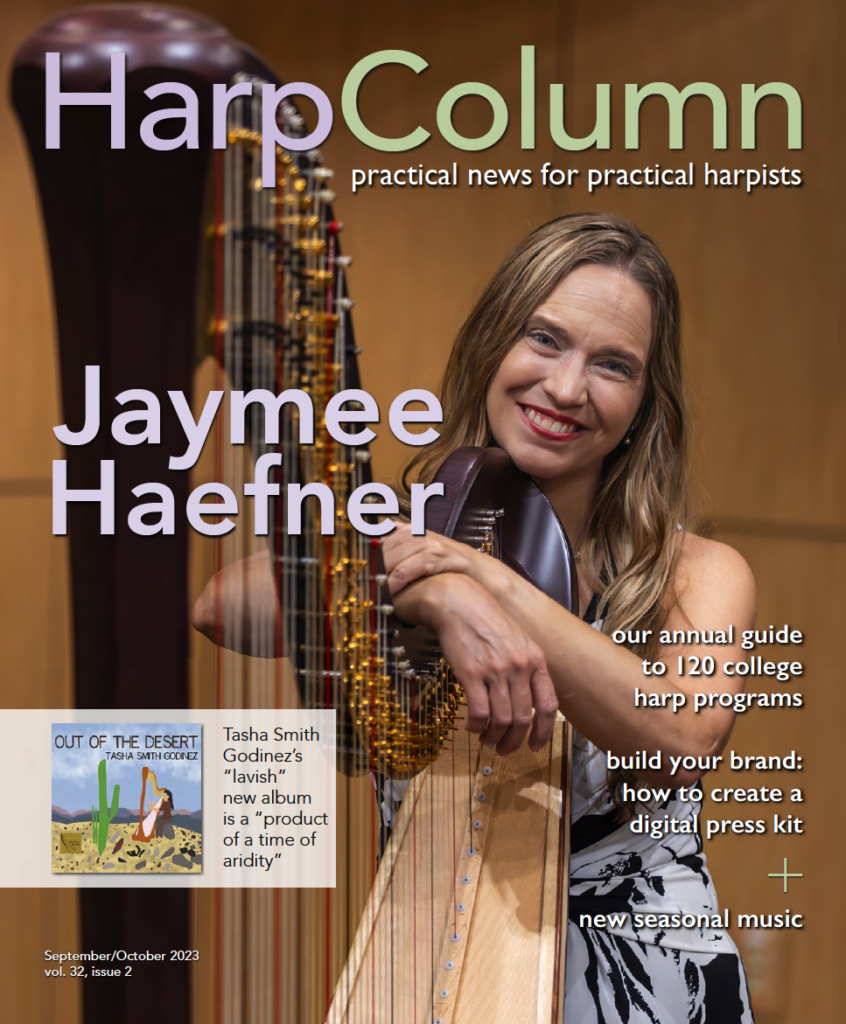
Download this issue to get this tune now!
Each installment of our Tear-Out Tunes series features a new piece written by one of the best harpist-composer-arrangers in the business. Each composer will tell you a little bit about their piece, and also give you some helpful tips for learning it and getting the most out of the experience.
The new piece (on the following pages) is yours to keep. We even put it right in the middle of the magazine so you can tear out the whole sheet and put your new tune on your music stand.
When first thinking about writing a piece for this new series, I wanted to create something that could be used in a performance setting as well as extend the technical and musical skills needed to play our beautiful instrument. First I will talk about the technical aspects and then outline the shape and feeling of the music.
I wanted to create something that could be used in a performance setting as well as extend the technical and musical skills needed to play our beautiful instrument.
Gently rolled chords—Chords are a major part of our harp color, so try to make the top note arrive with the melody note (measures 1–3, 29–21, 39). In m. 39, you can roll them a bit slower, as you are ending the piece peacefully. If you can’t manage four-note chords, then omit the top note.
Line—The main part consists of a smooth legato melodic line (mm. 1–20 and 29–40) and should be played with relaxed and slower articulation of the fingers. In contrast, in mm. 21–28 try to make the articulation of the right hand slightly quicker to give that detached note feel.
Left hand turning under—I’ve included an option to practice this in mm. 4 and 32. If this is tricky, then take the last three eighth notes with the right hand and lift off after the first note of the following bar.
Preparation and fingerings—As always, these are a guide and can be adapted to suit individual hands. The brackets are for connected preparation mainly for the legato smooth sounding melodic line. I’ve inserted commas in brackets to indicate lifting the hand before placing again.
Closed position—For the 4-2-1 and 4-1 fingerings in the right hand (e.g. m. 9 and m. 9 into 10), ending a phrase with the thumb can make that note ring and also relax the hand by slightly lifting the wrist.
Left hand taking a melody note—This happens in mm. 4, 13, 28, and 32. It is mainly for fingering position facility, but be sure to make that melodic note sound as important as if the right hand was playing it.
Harmonics—This can be an area of trepidation for many, so if you’re not sure in a performance situation, then play the harmonics as natural notes an octave higher than written. However, it’s worth practicing harmonics, as they are one of the most beautiful effects we have. The piece is written in three flats so harmonics should sound more easily. Try to keep the hands relaxed, and don’t attack the harmonics. Again, push in the wrist and lift off with the thumb. If your hands are relaxed, your harmonics will sound amazing!
Left-hand arpeggios—For the 4-2-1 arpeggios in the left hand, lift the wrist slightly after each group (e.g. mm. 25–28) to give a nice legato effect in contrast with the right hand.
Left-hand muffle—In m. 20, take time to muffle the low C so the next section can start cleanly in E-flat major.
Dynamics, phrasing, and tempo choices—I’ve tried to indicate some dynamics, but this is always a choice for the player. Music comes to life when it ebbs and flows, so really go with what you feel and then it will come across to your audience. The phrases are the sentences you speak in music and are usually rounded off in sound at the end. They also mean you can breathe in the music while you play just like a singer or a wind player.
Tempo and speed—This little piece can be performed gently in a lilting slow style or more energetically with a stronger dance-like jig rhythm according to your level and how you’re feeling that day. The ending could also be a big crescendo with a flashy loud finish if you wish.
I hope you enjoy playing my little piece, and I wish you all happy harping! •








